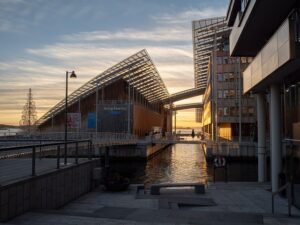

Tech Talk: Discussing Technology and Social Media in Norwegian
Norway, known for its stunning natural landscapes and high standard of living, has also become a hub for technology and social media. The intersection of these two forces has had a profound impact on Norwegian society, shaping its culture, politics, economy, and education system. It is crucial to understand the implications of this impact in order to navigate the challenges and opportunities that arise from the integration of technology and social media in Norway.
Table of Contents
ToggleKey Takeaways
- Technology and social media have intersected in Norway, leading to various impacts on society.
- Digital marketing has become a crucial aspect of business strategies in Norway, with best practices emerging.
- E-commerce in Norway is predicted to continue growing, with new trends and innovations on the horizon.
- Technology presents both opportunities and challenges for education in Norway, requiring careful consideration.
- Cybersecurity threats are a concern for individuals and businesses in Norway, but solutions are available.
The Impact of Social Media on Norwegian Society
Social media usage in Norway is widespread, with a large majority of the population actively engaging with various platforms. According to a report by Statistics Norway, 85% of Norwegians aged 16-79 use social media regularly. This high level of engagement has transformed the way Norwegians communicate, consume information, and interact with businesses.
The impact of social media on Norwegian culture is evident in the way people share and consume content. Social media platforms have become a space for cultural expression and identity formation. Norwegians use social media to showcase their interests, hobbies, and values, creating virtual communities that transcend geographical boundaries.
In politics, social media has played a significant role in shaping public opinion and mobilizing citizens. Political parties and candidates utilize social media platforms to reach voters directly, bypassing traditional media channels. This has led to increased political engagement among Norwegians, as they can easily access information about candidates and participate in online discussions.
From an economic perspective, social media has revolutionized marketing strategies in Norway. Businesses now have direct access to their target audience through social media platforms, allowing for more personalized and targeted advertising campaigns. Additionally, social media influencers have emerged as powerful marketing tools, as their endorsements can greatly influence consumer behavior.
While social media presents numerous opportunities for Norwegians, it also poses challenges. The spread of misinformation and fake news is a growing concern in Norway, as it can undermine trust in institutions and distort public discourse. Additionally, the addictive nature of social media can have negative effects on mental health and social interactions.
The Rise of Digital Marketing in Norway
The rise of social media and technology has also led to the growth of digital marketing in Norway. Businesses are increasingly investing in online advertising and utilizing digital platforms to reach their target audience. The digital marketing landscape in Norway is highly competitive, with companies constantly seeking innovative strategies to stand out in the digital space.
Successful digital marketing campaigns in Norway often involve a combination of targeted advertising, engaging content, and data-driven insights. Companies leverage social media platforms, search engine optimization (SEO), and email marketing to reach their desired audience. They also utilize analytics tools to measure the effectiveness of their campaigns and make data-driven decisions.
One notable example of a successful digital marketing campaign in Norway is the “Do You Dare?” campaign by Norwegian Airlines. The campaign utilized social media platforms to engage with potential customers and encourage them to take risks and explore new destinations. The campaign generated significant buzz and increased brand awareness for Norwegian Airlines.
The Future of E-commerce in Norway
| Metrics | 2019 | 2020 | 2021 |
|---|---|---|---|
| Online sales growth rate | 11.5% | 14.8% | 16.2% |
| Number of online shoppers | 3.1 million | 3.4 million | 3.7 million |
| Mobile commerce sales | 3.2 billion | 3.9 billion | 4.5 billion |
| Percentage of online shoppers using mobile devices | 60% | 65% | 70% |
| Top e-commerce categories | Electronics, fashion, home & garden | Electronics, fashion, home & garden | Electronics, fashion, home & garden |
E-commerce has experienced significant growth in Norway, driven by advancements in technology and changing consumer behavior. According to a report by the Norwegian E-commerce Association, online sales in Norway reached 19 billion NOK in 2020, representing a 17% increase from the previous year.
The future of e-commerce in Norway is promising, with several trends and predictions emerging. One trend is the rise of mobile commerce, as more Norwegians are using their smartphones to make purchases. Another trend is the increasing demand for sustainable and ethical products, as consumers become more conscious of their environmental impact.
However, e-commerce also presents challenges for Norwegian businesses. One challenge is the need for robust logistics and delivery systems to ensure timely and efficient delivery of products. Another challenge is the threat of cybercrime, as online transactions can be vulnerable to hacking and fraud.
The Role of Technology in Norwegian Education
Technology has the potential to transform education in Norway, providing new opportunities for learning and collaboration. Digital tools and platforms can enhance the learning experience, allowing students to access educational resources from anywhere and at any time. Technology also enables personalized learning, as students can progress at their own pace and receive tailored feedback.
However, there are challenges and limitations to the integration of technology in Norwegian education. One challenge is the digital divide, as not all students have equal access to technology and internet connectivity. This can exacerbate existing inequalities in education and hinder the full potential of technology in the classroom.
Another challenge is the need for effective teacher training and support. Teachers must be equipped with the necessary skills and knowledge to effectively integrate technology into their teaching practices. Professional development programs and ongoing support are crucial to ensure that teachers can leverage technology to enhance student learning.
The future of technology in Norwegian education holds great promise. Virtual reality (VR) and augmented reality (AR) technologies have the potential to create immersive learning experiences, allowing students to explore complex concepts in a hands-on manner. Artificial intelligence (AI) can also play a role in personalized learning, as it can analyze student data and provide targeted interventions.
Cybersecurity in Norway

As technology becomes increasingly integrated into all aspects of Norwegian society, cybersecurity has become a critical concern. Norway faces various cybersecurity threats, including hacking, data breaches, and ransomware attacks. These threats can have severe consequences for individuals, businesses, and even national security.
To protect against cyber threats, individuals and businesses in Norway must adopt robust cybersecurity measures. This includes using strong passwords, regularly updating software and antivirus programs, and being cautious of phishing attempts. It is also important to educate individuals about cybersecurity best practices to ensure they are aware of potential risks.
From a national perspective, Norway has implemented various initiatives to enhance cybersecurity. The Norwegian National Security Authority (NSM) is responsible for coordinating efforts to protect critical infrastructure and combat cyber threats. The government also collaborates with international partners to share information and best practices in cybersecurity.
The Importance of Digital Transformation for Norwegian Companies
Digital transformation has become a necessity for Norwegian companies to remain competitive in today’s digital age. Digital transformation involves the integration of digital technologies into all aspects of a business, from operations and customer service to marketing and sales.
Successful digital transformation in Norwegian companies often involves a shift in mindset and culture. It requires a willingness to embrace change and adapt to new technologies. Companies must also invest in the necessary infrastructure and resources to support digital transformation initiatives.
One example of a successful digital transformation in Norway is the retail industry. Traditional brick-and-mortar stores have embraced e-commerce and omnichannel strategies to meet the changing needs and preferences of consumers. Companies that have successfully implemented digital transformation initiatives have seen increased sales, improved customer satisfaction, and enhanced operational efficiency.
However, digital transformation also presents challenges for Norwegian companies. One challenge is the need for skilled professionals who can drive digital transformation initiatives. There is a growing demand for individuals with expertise in areas such as data analytics, artificial intelligence, and cybersecurity.
Another challenge is the potential resistance to change within organizations. Digital transformation often requires significant organizational restructuring and changes to existing processes. Companies must effectively communicate the benefits of digital transformation to employees and provide training and support to ensure a smooth transition.
The Ethics of Artificial Intelligence
Artificial intelligence (AI) has the potential to revolutionize various industries in Norway, from healthcare and finance to transportation and manufacturing. However, the ethical considerations surrounding AI must be carefully examined to ensure its responsible and ethical use.
One ethical consideration is the potential bias in AI algorithms. AI systems are trained on large datasets, which can contain biases that reflect societal prejudices. This can result in discriminatory outcomes, such as biased hiring practices or unfair treatment in healthcare.
Another ethical consideration is the impact of AI on employment. As AI technology advances, there is a concern that it may replace human workers, leading to job displacement and increased inequality. It is important to ensure that the benefits of AI are distributed equitably and that measures are in place to support workers affected by automation.
The Norwegian Data Protection Authority has published guidelines on the responsible use of AI, emphasizing the need for transparency, accountability, and fairness. The government is also investing in research and development to explore the ethical dimensions of AI and develop frameworks for its responsible use.
The Role of Social Media in Norwegian Politics
Social media has had a significant impact on Norwegian politics, transforming the way political campaigns are conducted and influencing public opinion. Political parties and candidates now utilize social media platforms to reach voters directly, bypassing traditional media channels.
Social media allows politicians to engage with voters in real-time and create a sense of authenticity and transparency. It also enables citizens to participate in online discussions and express their opinions on political issues. This has led to increased political engagement among Norwegians, particularly among younger generations.
However, social media also presents challenges for Norwegian politics. The spread of misinformation and fake news is a growing concern, as it can undermine trust in institutions and distort public discourse. Social media platforms must take responsibility for addressing this issue by implementing measures to detect and remove false information.
The future of social media in Norwegian politics holds both opportunities and risks. On one hand, social media can facilitate greater citizen participation and democratize the political process. On the other hand, it can also amplify polarization and echo chambers, as individuals are more likely to be exposed to like-minded opinions.
The Digital Divide in Norway
While Norway is known for its high level of digital connectivity, there is still a digital divide that exists within the country. The digital divide refers to the gap between those who have access to technology and the internet and those who do not.
In Norway, the digital divide is primarily driven by factors such as age, income, and geographical location. Older individuals, low-income households, and those living in rural areas are more likely to have limited access to technology and the internet.
The digital divide poses challenges in terms of access to information, education, and economic opportunities. Those who are digitally excluded may struggle to access online services, participate in online learning, or take advantage of e-commerce opportunities.
To address the digital divide in Norway, efforts must be made to ensure equal access and inclusion for all citizens. This includes improving internet infrastructure in rural areas, providing affordable internet access options, and offering digital literacy training programs for individuals who may be less familiar with technology.
The intersection of technology and social media has had a profound impact on Norwegian society, shaping its culture, politics, economy, education system, and more. It is crucial to understand the implications of this impact in order to navigate the challenges and opportunities that arise from the integration of technology and social media in Norway.
From the rise of digital marketing and e-commerce to the role of technology in education and the ethical considerations surrounding artificial intelligence, there are numerous areas where technology is transforming Norwegian society. It is important for individuals, businesses, and policymakers to stay informed about these developments and actively engage in discussions about their implications.
By understanding the intersection of technology and social media in Norway, we can harness its potential for positive change while mitigating its risks. Continued exploration and analysis of technology’s impact on Norwegian society will ensure that we can navigate this rapidly evolving landscape with knowledge and foresight.
If you want to learn Norwegian, you can register for classes here. We look forward to hearing from you and helping you become fluent in Norwegian!
If you want to learn Norwegian, you can register for classes here. We look forward to hearing from you and helping you become fluent in Norwegian.





